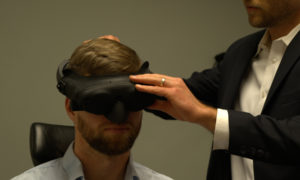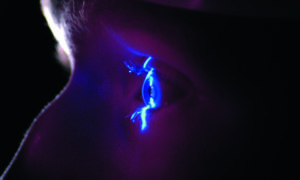By Ken Krivacic, OD, MBA
Instrumentation is a major investment, but if you calculate ROI correctly you can elevate the level of service you provide—and boost your bottom line. Compute patient needs and identify your break-even point, then project your profit potential.
The instruments you add to your practice to monitor your patients’ eye health and deliver superior eyewear connects directly to the standard of service you are able to provide. Most of us want to provide the best possible service to patients, but with just one piece of instrumentation sometimes a more than $50,000 investment, it is important to also consider our finances. Here are tips on how to analyze and then calculate which instrumentation you can afford and which instruments you should take a pass on for now.
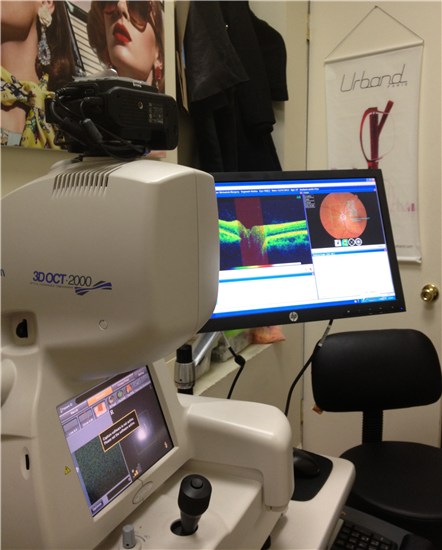 Instruments as a Cost in the Budget
Instruments as a Cost in the Budget
In my practice’s budget, any instrument that can be used to monitor eye health or aids in performing an eye exam is included in the equipment cost category of the overall budget. These include any instrumentation related to performing an eye exam such as exam lane equipment, auto-refractors, keratometers, specular microscopes, retinal cameras and OCTs. There are other pieces of equipment that help in other areas of the office and we include those in other expense categories in the overall office budget. The prime example for us is an in-house edger. The cost of the edger is included in cost of goods. We include computer equipment related to electronic records or practice management in the general office category of the budget.
Which Instruments Are Worth the Expense?
When budgeting for a new piece of equipment, the first question that needs to be asked is will it benefit the patient and the office? If the equipment provides more information to make a diagnosis more easily attainable then it may be worth the cost. For instance, if having a retinal camera helps you confirm a retinal detachment that may have gone undetected otherwise, then the value of that equipment may exceed the actual monthly payment. What is the cost of a lawsuit from a missed retinal tear or detachment? Some pieces of equipment pay for themselves in reducing the potential loss of earnings due to a missed diagnosis.
In general, though, most equipment can be looked at in terms of how it contributes to the patient experience, and conversely, how it contributes to the bottom line for the practice. Return on Investment (ROI) is a great place to start. In other words, what does the practice gain for the dollars it spends on a piece of equipment?
Calculate ROI
I generally like to evaluate the worth of investing in a piece of equipment based on both ROI and a break-even analysis. ROI would tell us how much net income we can generate from a piece of equipment over a given time period. You could make that time period monthly, yearly or over the life of a loan or over the life of the instrument. I generally like to look at ROI over both monthly and yearly estimates. Also keep in mind in doing the exercise that we are merely making a best guess analysis. For instance, let’s say you want to purchase a retinal camera. What is the estimated ROI we expect to generate? Let’s perform an example:
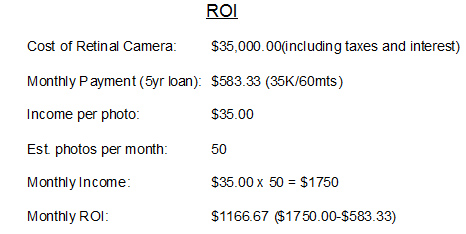
In this example the question of whether to purchase the camera would be easy to answer. It would be foolish not to make that investment. Also note that I call the transaction an investment. An investment implies that the product you are buying will return an income. A purchase merely implies you are buying a product that may or may not return an income.
Let’s go back to our example and say that we possibly overestimated how many photos we would perform per month. Let’s say we only do half the number of photos that we estimated. Is the camera still a good investment? In that scenario the monthly income drops to $900. The payment remains the same and our monthly income drops to $316.67. Not as good as initially estimated but still not bad. Would you still make that investment? I would.
So, how does ROI compare to a break-even analysis? A break-even analysis will tell us at what point the investment will generate a profit. Let’s go back to our example above.
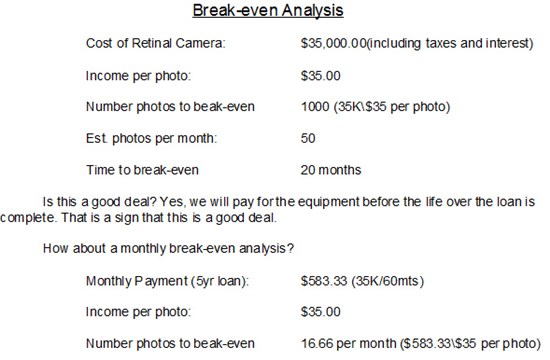
Think In Terms of Practice-Building
In most cases ROI or a break-even analysis are the main guiding principles when deciding to purchase a new piece of equipment. There may be certain cases where those analytics are difficult to figure. Sometimes a piece of equipment may just benefit the patient and make the office look better in the patient’s eyes (excuse the pun). A case in point for our office was the purchase of a digital phoropter. Up until a few years ago, we performed refractions on a manual phoropter. How much different is your prescription going to be whether it’s performed on a manual phoropter or a digital one? In most cases not much. What we noticed after purchasing our first digital phoropter was that patients noticed the difference. They not only noticed the difference, but they repeatedly commented on it. They felt like they were getting a better eye exam. Most had never had an exam performed on a digital phoropter and this made our exam and office appear more cutting edge than the previous office they had been to.
Sometimes it’s good to add equipment that will elevate the quality of the experience the patient receives in your office. Yes, it may be a cost that has an ROI that is difficult to calculate. How many referrals did our digital phoropters generate? How many extra eyeglasses did we sell because we performed a refraction on a digital phoropter? For this piece of equipment, those numbers were extremely difficult to figure. Yet we proceeded because we had an intuition that the equipment was modern enough and provided enough of a “wow” factor to move forward with a purchase. Since we still had reservations about our return on investment, we proceeded slowly. We only dipped our toe in the water by purchasing one unit for our potential five exam lanes. After the overwhelming patient acceptance of the new technology, we ended up purchasing three more units.
If you are not sure about a piece of equipment, you can always start small if you need multiple units. If only one unit is needed, consult with the equipment rep and they may be able to let you trial a unit for a few days to see you garner the positive responses not only from patients, but from yourself and the office staff.
Factor in Add-On Costs
In some cases just purchasing the equipment may not reflect the total cost of bringing that piece of equipment into your office. For instance, a new auto-keratometer may require a table or possibly a laptop to make the keratometer functional. These additional costs should be factored into your budget for that piece of equipment.
Consider Cost of Training Staff on New Instrument
You could factor in the time and possible money it would cost to train staff on a new piece of equipment. In our practice we do not factor that into our break-even analysis. An example of this is when we upgraded our practice management software to become compliant with the new meaningful use guidelines. We knew there would be down-time to train staff and that the initial implementation of the new software would slow down our ability to see the same number of patients that we normally would. We realized this would result in a loss of revenue, yet we still proceeded. I believe you have to look long-term in those cases where the equipment will be around for a number of years. In this case, unless something unexpected happens, we intend to use this software for at least the next ten years. If you spread the lost revenue over that time-frame it makes that a fraction on the overall investment.
Know When to Take a Break from Instrumentation Purchases
Since we recently purchased an OCT, we have taken ourselves out of the equipment market for now. How long is “now”? I generally feel it’s beneficial to patients and the practice to stay current on technology and show patients that you are staying current. With that philosophy, we normally look at adding a new piece of equipment to the practice on a yearly basis depending on cost. You still want to keep your expenses in line, and the budget can tell you if it’s time to purchase new equipment or if you need to wait. A good guideline for this is to keep cost related to equipment to between 3 percent and 5 percent of your budget.
Instrumentation Budgeting: Action Plan
Add a new piece of equipment every year if possible. It will generate more income, make you a better doctor and show your patients you care about keeping up with new technologies.
Be sure you have a budget to follow. Keep cost for equipment between 3 percent and 5 percent of total income. This is a good guideline to follow when deciding if it’s time to make a purchase.
Run an estimated cost analysis on all equipment before purchasing. Use both an ROI and break-even analysis.
Be realistic, you won’t hit a home run on every purchase. Some don’t work out like you thought. You can look at that as the cost of doing business. You can always sell if it becomes a financial drag on the practice’s finances.
Related ROB Articles
Occupancy Costs: Manage Effectively, Free Up Funds for Practice-Building
Track Your Staffing Costs: A Key to Practice Profitability
Track Your COG: Manage Well for Profitability
Ken Krivacic, OD, is the owner of Las Colinas Vision Center in Irving, Texas. To contact him: kkrivacic@aol.com.



